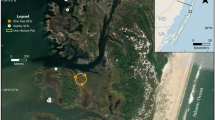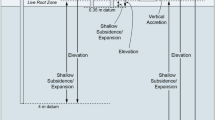Abstract
Scientists investigating wetland soil vertical development have required a high precision, high accuracy technique to measure wetland surface elevation change over time. The Surface Elevation Table (SET), capable of millimeter-scale precision, has proven effective in supporting hypothesis-based inquiry into mechanisms of wetland vertical development. More recently, SET sampling stations have been established in many areas to monitor wetland elevation change in an effort to gauge wetland resilience to accelerated sea level rise. Unfortunately, each SET sampling station covers an area of about 1 m2, and the technique was not designed to monitor elevations across broad, hectare-sized spatial scales. The purpose of this study is to investigate an alternative method for obtaining repeated, high-precision measurements of wetland elevation and elevation change that could easily be extended to the hectare scale. This study compares the precision and accuracy of a novel digital barcode leveling technique to the now well-accepted SET for the purposes of measuring wetland surface elevation change. Results suggest that leveling can provide wetland elevations with similar vertical precision as the SET over much larger spatial scales and with an instrument that costs about the same as the SET.







Similar content being viewed by others

References
Boumans, Rouel M.J., and John W. Day Jr. 1993. High precision measurements of sediment elevation in shallow coastal areas using a sedimentation-erosion table. Estuaries 16 (2): 375–380.
Cahoon, Donald R. 2015. Estimating relative sea-level rise and submergence potential at a coastal wetland. Estuaries and Coasts 38 (3): 1077–1084.
Cahoon, Donald R., Denise J. Reed, and John W. Day Jr. 1995. Estimating shallow subsidence in microtidal salt marshes of the southeastern United States: Kaye and Barghoorn revisited. Marine Geology 128: 1–9.
Cahoon, Donald R., Paul E. Marin, Brian K. Black, and James C. Lynch. 2000. A method for measuring vertical accretion, elevation, and compaction of soft, shallow-water sediments. Journal of Sedimentary Research 70 (5): 1250–1253.
Cahoon, Donald R., James C. Lynch, Philippe Hensel, Rouel Boumans, Brian C. Perez, Bradley Segura, John W. Day, and Jr.. 2002a. High-precision measurements of wetland sediment elevation: I. Recent improvements to the sedimentation-erosion table. Journal of Sedimentary Research 72 (5): 730–733.
Cahoon, Donald R., James C. Lynch, Brian C. Perez, Bradley Segura, Roger D. Holland, Carroll Stelly, Gary Stephenson, and Philippe Hensel. 2002b. High-precision measurements of wetland sediment elevation: II. The rod surface elevation table. Journal of Sedimentary Research 72 (5): 734–739.
Cahoon, Donald R., Philippe F. Hensel, Tom Spencer, Denise J. Reed, Karen L. McKee, and Neil Saintilan. 2006. Coastal wetland vulnerability to relative sea-level rise: wetland elevation trends and process controls. In: Verhoeven J., D. Whigham, R. Bobbink, and B. Beltman (eds). Wetlands as a natural resource, Springer ecological studies series Vol. 190, pp. 272–292.
Craft, Chris, Johnathan Clough, Jeff Ehman, Samantha Joye, Ricahrd Park, Steve Pennings, Hongyu Guo, and Megan Machmuller. 2009. Forecasting the effects of accelerated sea-level rise on tidal marsh ecosystem services. Frontiers in Ecology and the Environment 7 (2): 73–78.
DeLaune, Ronald D., James A. Nyman, Willaim H. Patrick, and Jr. 1994. Peat collapse, ponding and wetland loss in a rapidly submerging coastal marsh. Journal of Coastal Research 10 (4): 1021–1030.
Gesch, Dean B. 2009. Analysis of Lidar data for improved identification and delineation of lands vulnerable to sea-level rise. Journal of Coastal Research 25 (6): 49–58.
Harrison, Ellen Z., and Arthur L. Bloom. 1977. Sedimentation rates on tidal salt marshes in Connecticut. Journal of Sedimentary Petrology 47 (4): 1484–1490.
Henning, William. 2011. User Guidelines for Single Base Real Time GNSS Positioning. Retrieved from NOAA: National Geodetic Survey: http://www.ngs.noaa.gov/PUBS_LIB/NGSRealTimeUserGuidelines. v2, 1. Accessed 3/4/2016.
Kana, Timothy W., Bart J. Baca, and Mark L. Williams. 1988. Charleston case study. In Greenhouse effect, sea level rise, and coastal wetlands, ed. J.G. Titus, 37–59. Washington D.C.: Office of Policy Analysis, United States Environmental Protection Agency.
Kirwan, M.L., and J.P. Megonigal. 2013. Tidal wetland stability in the face of human impacts and sea-level rise. Nature 2013 (504): 53–60.
Kirwan, Matthew L., Stijn Timmerman, Emily E. Skeehan, Glenn R. Guntenspergen, and Sergio Fagherazzi. 2016. Overestimation of marsh vulnerability to sea level rise. Nature Climate Change 2016 (6): 253–260.
Langley, J. Adam, Karen L. McKee, Donald R. Cahoon, Julia A. Cherry, and Patrick Megonigal. 2009. Elevated CO2 stimulates marsh elevation gain, counterbalancing sea-level rise. Proceedings of the National Academy of Sciences 106 (15): 6182–6186.
Lovelock, Catherine E., Donald R. Cahoon, Daniel A. Friess, Glenn R. Guntenspergen, Ken W. Krauss, Ruth Reef, Kerrylee Rogers, Megan L. Saunders, Frida Sidik, Andrew Swales, Neil Saintilan, Le Xuan Thuyen, and Tran Triet. 2015. The vulnerability of Indo-Pacific mangrove forests to sea-level rise. Nature 526: 559–563.
Lynch, James C., Philippe Hensel, and Donald R. Cahoon. 2015. The surface elevation table and marker horizon technique: A protocol for monitoring wetland elevation dynamics. Natural Resource Report NPS/NCBN/NRR—2015/1078. National Park Service, Fort Collins, Colorado.
McKee, Karen L. 2011. Biophysical controls on accretion and elevation change in Caribbean mangrove ecosystems. Estuarine, Coastal and Shelf Science 91: 475–483.
McKee, Karen L., and William H. Patrick Jr. 1988. The relationship of smooth cordgrass (Spartina alterniflora) to tidal datums: A review. Estuaries 11: 143–151.
McKee, Karen L., Donald R. Cahoon, and Ilka C. Feller. 2007. Caribbean mangroves adjust to rising sea level through biotic controls on change in soil elevation. Global Ecology and Biogeography 16: 545–556.
Medeiros, Stephen, Scott Hagen, John Weishampel, and James Angelo. 2015. Adjusting Lidar-derived digital terrain models in coastal marshes based on estimated aboveground biomass density. Remote Sensing 7: 3507–3525.
Morris, James T., P.V. Sundareshwar, Christopher T. Nietch, Bjorn Kjerfve, and Donald R. Cahoon. 2002. Responses of coastal wetlands to rising sea level. Ecology 83: 2869–2877.
National Estuarine Research Reserve System. 2012. Sentinel Sites Program Guidance for Climate Change Impacts. Retrieved from NOAA: Office for Coastal Management: https://coast.noaa.gov/data/docs/nerrs/Research_SentinelSitesGuidanceDoc.pdf. Accessed 3/4/2016.
Nyman, James A., Ronald D. DeLaune, Harry H. Roberts, William H. Patrick, and Jr. 1993. Relationship between vegetation and soil formation in a rapidly submerging coastal marsh. Marine Ecology Progress Series 96: 269–279.
Raposa, Kenneth, Kerstin Wasson, Erik Smith, Jeffrey A. Crooks, Patricia Delgado, Sarah H. Fernald, Matthew C. Ferner, Alicia Helms, Lyndie A. Hice, Jordan W. Mora, Brandon Puckett, Ddnise Sanger, Suzanne Shull, Lindsay Spurrier, Rachel Stevens, and Scott Lerberg. 2016. Assessing tidal marsh resilience to sea-level rise at broad geographic scales with multi-metric indices. Biological Conservation 204 (2016): 263–275.
Reed, Denise J. 1995. The response of coastal marshes to sea level rise: Survival or submergence? Earth Surface Processes and Landforms 20: 39–48.
Reed, Denise J. 2002. Sea-level rise and coastal marsh sustainability: Geological and ecological factors in the Mississippi delta plain. Geomorphology 48: 233–243.
Renschler, C.S., D.C. Flanagan, B.A. Engel, L.A. Kramer, and K.A. Sudduth. 2002. Site-specific decision-making based on RTK GPS survey and six alternative elevation data sources: Watershed topography and delineation. Am Soc Agric Eng 45 (6): 1883–1895.
Smith, Stephen M., and Scott Warren. 2007. Determining ground surface topography in tidal marshes using watermarks. Journal of Coastal Research 23 (1): 265–269.
Soler, T., P. Michalak, N.D. Weston, R.A. Snay, and R.H. Foote. 2006. Accuracy of OPUS solutions for 1- to 4-h observing sessions. GPS Solutions 110 (1): 45–55.
Stevenson, J. Court, Larry G. Ward, and Michael S. Kearney. 1986. Vertical accretion in marshes with varying rates of sea level rise. In Estuarine variability, ed. Douglas A. Wolfe, 241–260. Orlando: Academic Press.
Stumpf, Richard P. 1983. The process of sedimentation on the surface of a salt marsh. Estuarine, Coastal and Shelf Science 17: 495–508.
Swales, Andrew, Paul Denys, Vernon I. Pickett, and Catherine E. Lovelock. 2016. Evaluating deep subsidence in a rapidly-accreting mangrove forest using GPS monitoring of surface-elevation benchmarks and sedimentary records. Marine Geology 380: 205–2018.
Ward, Raymond D., Niall G. Burnside, Chistopher B. Joyce, and Kalev Sepp. 2013. The use of medium point density LiDAR elevation data to determine plant community types in Baltic coastal wetlands. Ecological Indicators 33: 96–104.
Ward, R.D., N.G. Burnside, C.B. Joyce, K. Sepp, and P.A. Teasdale. 2016. Improved modelling of the impacts of sea level rise on coastal wetland plant communities. Hydrobiologia 774: 203–216.
Webb, Edward L., Daniel A. Friess, Ken W. Krauss, Donald R. Cahoon, Glenn R. Guntenspergen, and Jacob Phelps. 2013. A global standard for monitoring coastal wetland vulnerability to accelerated sea-level rise. Nature Climate Change 3: 458–465.
Acknowledgements
This research was supported by the National Oceanic and Atmospheric Administration (NOAA) Hollings Scholarship award to Molly Cain. Assistance in field data collection from Heather Nicholson and Jay Howard was greatly appreciated. We also thank the Jug Bay Superintendent Patricia Delgado and the Assateague Island GIS Specialist Neil Winn for help in the field and access to their field sites. We are grateful to the Smithsonian Environmental Research Center Deputy Director Pat Megonigal for insights throughout the study and for access to the Smithsonian wetland sites. Finally, we wish to thank the Chesapeake Bay Environmental Center and Assistant Director Vicki Paulas for their support of this research.
Author information
Authors and Affiliations
Corresponding author
Additional information
Communicated by Cathleen Wigand
Rights and permissions
About this article
Cite this article
Cain, M.R., Hensel, P.F. Wetland Elevations at Sub-Centimeter Precision: Exploring the Use of Digital Barcode Leveling for Elevation Monitoring. Estuaries and Coasts 41, 582–591 (2018). https://doi.org/10.1007/s12237-017-0282-6
Received:
Revised:
Accepted:
Published:
Issue Date:
DOI: https://doi.org/10.1007/s12237-017-0282-6



